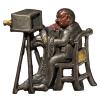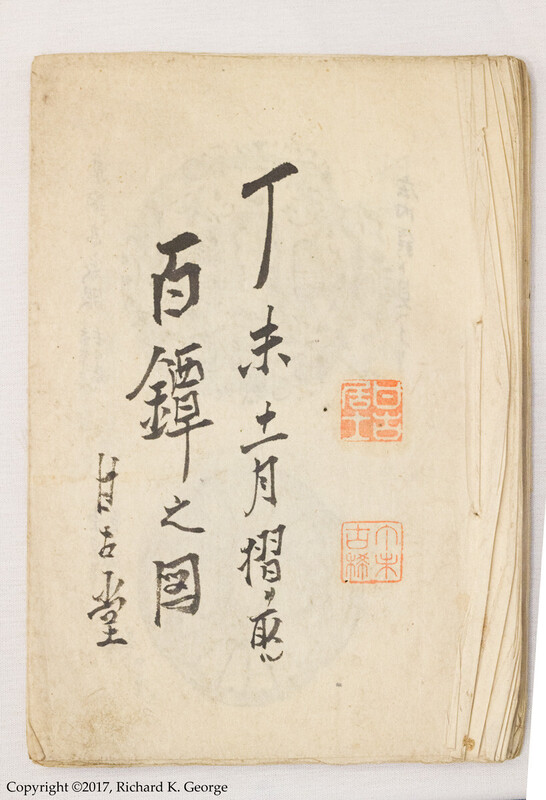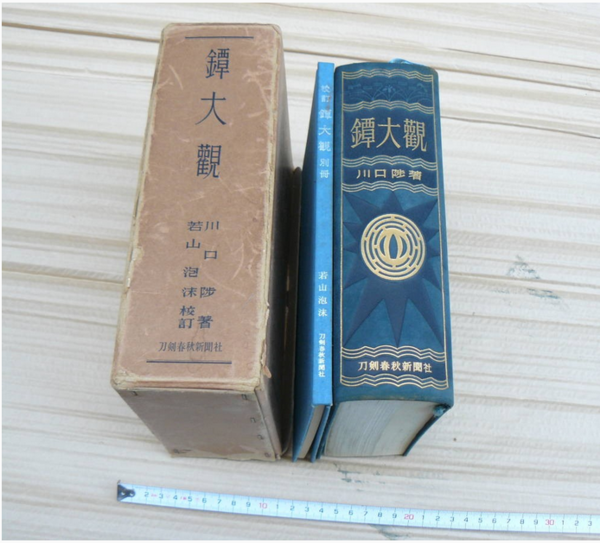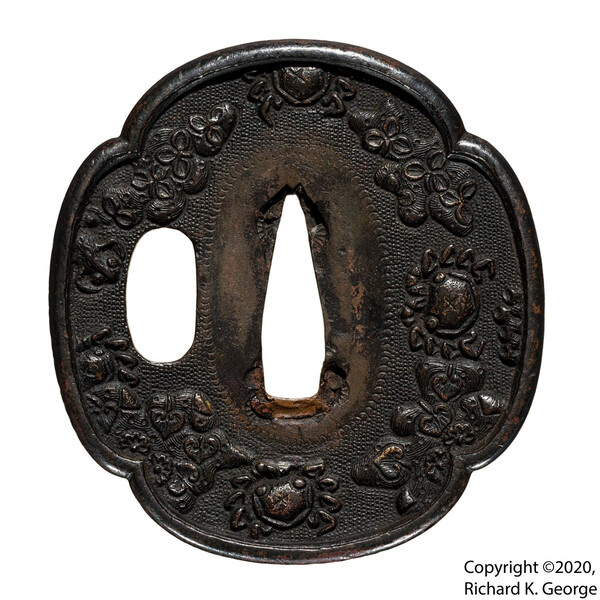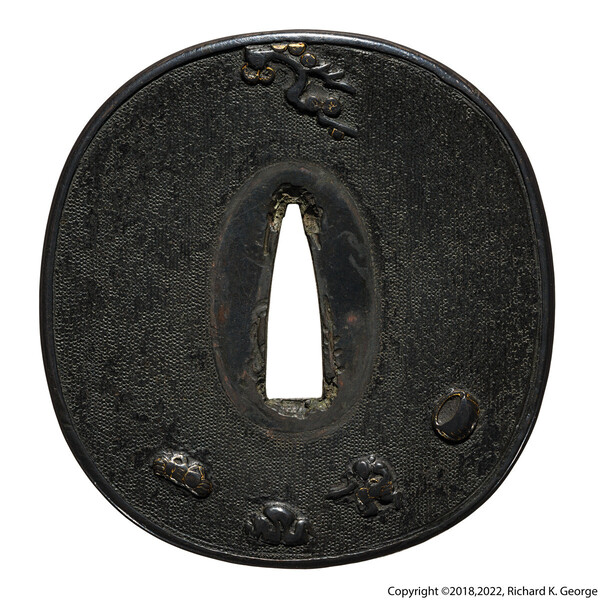-
Posts
817 -
Joined
-
Last visited
-
Days Won
8
Content Type
Profiles
Forums
Events
Store
Downloads
Gallery
Everything posted by rkg
-
This is a useful set, and there is an index or table of contents translation floating around. I think the pieces in Wakayama's kodogu 3 volume mei set (several of which have popped up lately on YJ, FWIW) is cross referenced to these too (or was it the other way around - too early in the morning (for me) to recall right now) Best, rkg (Richard George)
-
Brian, you could start by looking for comps on Yahoo!Japan maybe? There is a tremendous number of sales of fittings through that site, and would give you an idea of the "spot" price since the items actually sold (except when the seller decides he doesn't like the price, but that's a yahoo!Japan foible...) for example, I don't know how this set compares to the set above (the YJ one was actually pretty good/better than the ones shown perhaps), but here's a set that is along the lines of the one your pal has: https://www.sendico....hoo/item/q1096115829 https://page.auction.../auction/q1096115829 Just start putting similar things to what you want to value on your watch list and see where they end up. Good Luck - valuing stuff in thin markets is no joy. Best, rkg (Richard George)
-
David, Are you talking about the "red dot" pieces? I am not certain of the age of that collection (I don't know if its as early as meiji or if its later), but Bruce K. bought all the documentation related to that set a number of years ago off of yahoo!Japan (amazing what shows up there sometimes). In a momentary fit of weakness, he let me snap images of the pages where a tsuba I have from that collection + the cover off of one of the volumes: Maybe somebody out there will recognize the stamps so we might have a clue who put the collection together. Best, rkg (Richard George)
-
Brown waxed? Best, rkg (Richard George)
-
Haon, Period Tachi are few and far between, and as you point out, many of the extant ones were "special"/not for use. While I am sure there have been better special exhibitions put together at some point, the best collection I've seen of tachi (and actually armor as well) that actually saw use are at the Ōyamazumi Shrine on the island of Ōmishima in the Seto Inland Sea. The place is somewhat unique in that individuals in armies returning from battle would go there and gift the swords/armor they actually used in the battle they had just participated in as offerings. A lot of the items are not in the best of condition, but at least stuff like Nambokucho period nerikawa tsuba were still threaded on the blade, etc. so you can see what was supposed to have been there. At some point in the distant past there was a writeup by Jim Gilbert outlining his experiences there/had a few scans from the museum's book (I took no images in the museum when I was there - they get real mad if you do/go so far as to watch visitors on camera to make sure they don't - but I digress), etc, but the article seems to have vanished from the web. Best, rkg (Richard George)
-
Jimi-san, I always seem to be late to the party on these. Apologies in advance if the following sounds addled - I'm still not feeling that great, so... First off, be glad you are doing this now rather than in the bad old days when everybody had CRT monitors - they could be all over the place in terms of color temperature, gamma settings, intensity, etc., and worse yet everybody was convinced their monitors were perfect so it was a losing proposition to even try and have a conversation about what they saw on their monitor (diatribe about hours wasted trying to convince people who had no idea about color management/monitor calibration/etc that their monitor might be off omitted - suffice to say I just started always printing proofs to send after that). While people still do odd adjustments, its much less common now, so you -could- talk about lighting the images so you still can get a feeling for what the piece looks like I think. Probably the simplest way to model it would be to think of it as a limited color space where you have to reduce the contrast/dynamic range and probably a reduced range of colors as well (though fortunately, you may not run into that often) - and if you light accordingly (reduce the overall contrast /dynamic range of the image) you can probably get a good result, though that is a little unsatisfying as a photographer as using a large dynamic range lets you show more. Again there are books on color management that describe in gory detail all the problems with trying to get what you see on a monitor to match the item. About all you can do is make -your- colors as accurate as possible. I personally pretty much do a unique color profile for -every- image I care about, though you -can- just measure your typical lighting and apply that profile in to groups of images. If nothing else, you -can- put a target somewhere in the image space and just do a white balance adjustment to it. I have become a big fan of these little step wedges, as you can use the gray to set your lighting intensity, and the white to do a white balance adjustment, and... they have a scale too (although it looks like they no longer run it down one side unfortunately) https://www.bhphotovideo.com/c/product/286667-REG/QP_Card_GQP101_Qp_Calibration_Card_101.html For actual profile generation I use a calbrite colorchecker. I prefer using some kind of profile generation like this as it allows you to dial out many problems with the sensor/what adobe decided to add to their camera profile, etc - I started doing this waaay back when I was shooting with a 5D mkII as canon had messsed with the reds in a way that was almost impossible to dial out manually. https://calibrite.com/us/product/colorchecker-passport-duo/ (note that they got little un's Bigger 'uns, part of a kit with a monitor calibrator (another good thing for you to look into), etc.). But that's all a huge digression, as you were asking about your images. The front one looks like it could stand to either have the contrast reduced (shadows lighter) or you need to spend some time adding lighting to "shape" the badger and frog - I'm not sure what you wanted to show there - the back seems to reveal most everything, though if you are working on lighting the front the fish on the back might also be improved (the face on the fish is kind of cool and not emphasized) But even then you have to watch doing that too much because in hand its actually hard to see everything at once (and that can lead to unhappy buyers since they generally do not have optimal lighting) - I'll often take a lot of pictures rotating the piece through identical light. I assume you shot these under somewhat identical light, so the color difference is there, correct? This actually is not that uncommon on kinko work, fwiw - I've always assumed it had to do with one side being "protected" by the otoshi and the other being on display, but what do I know. Best, rkg (Richard George)
-
Washida school work would be my guess. Nice piece. Best, rkg (Richard George)
-
I got a tsuba not too long ago with this chant on it. 南無妙法蓮華教, Namu Myōhō Renge Kyō I posted to FB. and in the sprit of passing along useful info, Tom helm was kind enough to translate the inscription to common kanji so I could make heads or tails of it, and David Stiles was kind enough to offer this information: " basically is the core chant or central mantra of the Nichiren Sect of Japanese Buddhism. When chanting it you are expressing faith in the teachings of Lotus Sutra and its interpretation by the Kamakura Period Monk Nichiren" Obligatory image: Best, rkg (Richard George
-
Great piece - I guess if nothing else it -could- be binned as Heianjou zougan, but.... it's a step above what you normally see from the groups that produced pieces attributed to Heianjou zougan - I guess some kind of special order from them is a possibility though. I think it's also too old to be somebody like the Washida boys that often created high-quality over-the-top pieces in the heianjou/youshiro style. I am no Jingo expert, but, while a goofy hitsu sometimes points you in the higo group's direction, the hitsu looks either added or like it was modified later to that shape maybe, and... some of the types of inlay are atypical for them, and I feel the design is a little too much for them - I always think of them using simpler/visually more powerful subject matter - and, their iron was often "yummy", which this kind of isn't. Another possibility is some early shouami group. You sometimes make pieces that have several different types of inlay like this piece - Haynes would always joke that they did it to show off their skills - here's a ko-shouami I have that I think fits this - not as complex as your piece, but the mashup of nunome, iroe, inlay, figural work, etc, isn't typical for the Ko shouami guys, so its interesting/might be relevant here: Clear as mud, right? Thanks for sharing the piece. Best, rkg (Richard George)
-
Oops my bad - just posted the link to my agent of choice - here's the actual YJ link: https://page.auctions.yahoo.co.jp/jp/auction/t1088359151 Best, rkg (Richard George)
-
and... the tsuba taikan is another interesting one to thumb through - prices are all over the map though - here's one that just popped up on YJ: https://www.sendico.com/ayahoo/item/t1088359151 Obligatory screen shot from auction grabbed for posterity Best, rkg (Richard George)
-
I've seen these pieces often put in the Ounin or heianjou zougan bins. I'm not sure I'd go with kamakura, because while the ring might have been added, maybe the "drawer pulls" around the outside actually did contain inlay originally? But the form is popular, it could also be some by other group that did inlay (aizu shouami, etc). Is that a shakudo fukurin on it? If so I'd go with that being added later. Best, rkg (Richard George)
-
Good point on the encyclopedia. I still end up using the original all the time though. In a crowded office space small handbooks just on what you're interested in can be your friend (+ its easier to write notes in than the pdf file (for me anyway).). Also, be sure to watch yahoo!Japan for books - sometimes these large Japanese books show up in waves and sometimes they go for amazingly low prices (particularly if you can put up with a non- pristine copy). The trouble is that you can also literally go for years between seeing copies of some of them. And there's actually a large number of interesting books that aren't one of these "classics" that show up all the time, often don't go for much. Best, rkg (Richard George)
-
Jeremy, First off, on the new i phone - I have a pal that has gotten pretty good macro results just shooting through a jeweler's loupe - not exactly repeatable or anything, but when everything aligns it works and you can get some decent images. Sorry about the greek tome on using a microscope for this stuff - it was the muscle relaxants talkin' A lot of those low end inspection options are actually not bad, you can learn a lot with them, but its hard to get really good images (sensors used are necessarily low end), and since that's my groove... I tend to troll for used older gear - sometimes you get lucky.... Rant about working at places with amazing metrology gear before I got interested in this stuff omitted. Best, rkg (Richard George)
-
Jeremy, You might contact Markus directly about that. Best, rkg (Richard George)
-
Boy, that's tough, as there are actually a LOT of books out there that might be useful for you. All of the above are good, but here are a few off-the-wall suggestions you might look at. If you want to look at a large number of different styles themes, etc organized by what group made them, you might look at getting a copy of Tsuba Shusei (the elephant book) by Nakamura - mostly b/w images unfortunately, but it is quite the collection of pieces: https://www.japaneseswordbooksandtsuba.com/store/book/fittings-books/b525-tsuba-shusei-by-nakamura/ If you are just looking for "style" as in shapes, nomenclature, etc another book that you might find surprisingly useful is Kajihara Kotoken's visual glossary https://www.japaneseswordbooksandtsuba.com/store/book/sword-books/b364-nihonto-swords-of-Japan-a-visual-glossary-Japanese-volume/ Also, I'm not certain if it is in print anymore, but Markus Sesko's Handbook of Sword Fittings Related Terms summarizes a whole lot of kodogu related structures, shapes, construction techniques, etc - real handy when you are looking for the Japanese name for some feature. Good Luck, rkg (Richard George)
-
Jeremy, If you are going for a standard 14, look for one with the trinocular setup. Some stages are better than others for this work as well - the one I got came with a sliding/rotating stage which works pretty well, though I ended up using some of that magic non-linear grease on the sliding mechanism to stiffen it up. I have 10x eyepieces all around (the one that came on the trinocular port also had standard threads so you can easily screw a lens adapter into it). I normally use a 1.6 crop camera (canon SL2 if you care) with a old school 50mm macro lens and I get pretty good results with that if you shoot a white card with each lighting setup/use a gray card to get the exposure kind of correct. I then ALWAYS shoot tethered so you can see what you are focusing on (really nice to do on a big screen). you'll need to at least get a 2.5X objective - its the one I use most - I actually found one of their 1.25X objectives, but it is of limited use because its difficult to get light to the piece around it (you end up REAL CLOSE to the surface) - it might be useful if you had a rig that could apply light through the objective, but YMMV as I've never pursued getting the necessary bits and trying it. Note that there isn't a whole of depth of field so you pretty much always have to focus stack if you want to show much depth when shooting. you can actually get pretty good results by parking the focus at one extreme feature and doing the "turn the knob, take a picture repeat" thing. In general, the new systems are all around better for this (optics can be better, have at least an OK (resolution is usually poor, but...) camera built in, and many will automatically do the focus stacking for you - here's a youtube video I posted on the kodogu no sekai site on FB a while back: great to watch since he describes all the issues you will run into... I've posted a bunch of images I've done there over the years/posted some here too... Anyway, agreed on getting some other tools - all my metallurgy classes were sooo long ago so I can't suggest much on what to look for (it doesn't help I'm hopped up on painkillers/muscle relaxants at the moment too) - seems like you'd also want some stuff like an XRF spectrometer gun to play with (I'd dearly love to get one of these if the prices ever come down). Anyway, I should stop rambling now. Best, rkg (Richard George)
-
You have to be super careful with those fiberglass pencils - they will scratch the hell out of your patina if you're not REALLY careful (they go waay too fast)/I wouldn't recommend using them on anything important. That said, they seem somewhat useful to "tap" with (like a mini scaler) on those little mountains of corrosion you find sometimes - again, only as a last resort. You'd also be advised to use random patterns (swirls, etc) rather than linear motion in any other case when you are brushing with them - you see a lot of pieces where they dig at them with whatever in straight lines and it looks terrible when you study the results/look like scratches in your auction images (which is what they are). Aside from Ivory, horn, bamboo chopstick, cloth and the usual round Japanese horsehair brush (good luck finding them), for finer work you can get some small artist's bristle brushes (natural bristle, nothing synthetic for a number of reasons), cut them off close to the ferrule and have at it, though you'll probably have to crimp the ferrule (most of them aren't tight enough to keep the bristle from moving). I've become a big fan of these - its slow, but... and again, try not to always brush in a straight line all the time. For the basket cases there are also these larger Japanese pot scrubbing brushes (made out of bamboo or something) that might work better than the fiberglass brush (they don't damage the surface as much/instantly dig through any patina to raw metal like the fiberglass pens can/do) - but again, you have to be careful with those too as they aren't the most precise tool either. but they are actually common/easy to find/not too expensive/etc. The non fiberglass brushes are also good because you can just use your finger to protect a lot of features and just brush up to it - don't be doing that with the fiberglass brush (an old school metal eraser shield works better, but its metal too, so again be super careful). the non-fiberglass brushes can be slower... but that also gives you lots of time to stop before you've ripped too much off, etc. Also note that a LOT of pieces have wax (often colored - grrr)/oil on them you got to make an effort to get that off on the areas you are working so you can see what is happening. And if you're gonna do fiberglass, it goes everywhere (so be prepared to contain it - I usually make up a 'bowl/tray out of folded paper, let the piece sit on a paper towels. and just thow the while thing away between sessions), you should wear gloves (the little shards are annoying), etc and.. an optivisor/good lighting is your friend. Good Luck, rkg (Richard George)
-
That's a nice looking blade - I suppose you could argue it should be cheaper, but we all argue that, right? - you just kind of have to assume its Gendai/modern/its gonna be difficult to resell/you might take a loss and ask yourself if you like it $1400 much. I spent a scary amount of money getting a modern one polished from its as-finished state, so it seems like a bargain to me/I assume other people would just buy it as well. FWIW, obligatory osoraku image - Mine: Best, rkg (Richard George)
-
Dan, A man after my own heart... Several years ago by sheer luck I picked up a zeiss standard 14 and it kind of changed my world with regards to studying kodogu. I have to add my +1 to Dan's comments - anybody seriously studying kodogu needs something like this, and I'd also recommend a stereo microscope because of the way features just leap out at you. My unit has a trinocular port and while I can get pretty fair images through it you just don't see what you see through the eyepieces. FWIW, I've been thinking of building up a rig to hold my 3-d camera up to the eyepieces and see if I can record the effect (features jumping out at you), but since I think I'm the only guy who has a 3-D camera anymore it went to the bottom of my list. But I digress. My only other comment would be to be sure you actually pony up for some decent lighting. My normal go-to is an old school cold light source with dual gooseneck head, though you can also get some decent illumination using those itty bitty usb powered led lights on some of those usb gooseneck extensions (I have a usb power bank with a couple of outputs that works great as a counterweight for a couple of these). Being able to vary the intensity/direction/type of light is really helpful. There used to be a constant stream of these older units showing up, often with reasonably recent maintenance and dirt cheep (relative to what they cost originally/what a unit of equivalent quality would cost today), but that seems to have dried up unfortunately. Best, rkg (Richard George)
-
cleaned? rkg (Richard George)
-
I know you were asking for kani sukashi, but since some other people have put up others... here's a ko kinko one:\ best, rkg (Richard George)
-
E-books have an awful lot of potential. I played around with creating one or two in the past. You can start with a "book" containing the typical verbiage and images but you aren't bound by the space in a physical book (pun intended) so you can do all kinds of other stuff - use huge images you can zoom waay into to see minute details, have links to many images of an item/additional information, video, vr image sets, 3-d images, audio commentary, video clips, etc etc etc. Buuut... there's little money in creating specialty books to begin with(you're lucky if you break even usually if you include your time, etc), and people are cheep/and most don't think twice about making bootleg copies of any kind of IP in any kind of electronic format ensuring that it is -really- just a labor of love. A few museums (like the Met) will actually eventually put up pdfs of their exhibition publications for public consumption, but that is rare - as I noted earlier they are businesses and they can't stay in business if they don't have money coming in the door to continue operating and it can cost a fortune to do a book "right" - and if there's no return... Its not gonna get done. rkg (Richard George)


